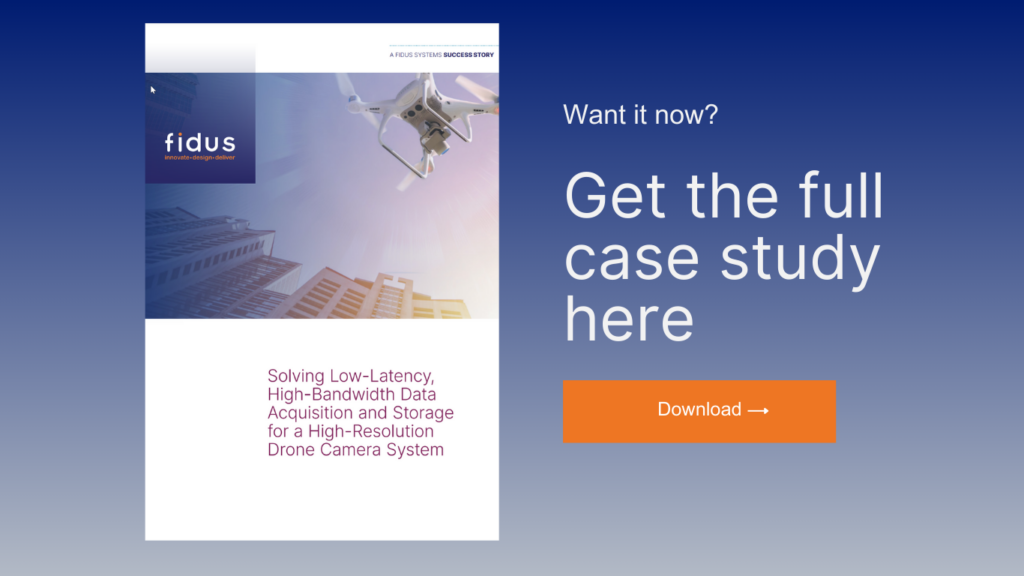A global aerospace leader faced significant challenges in achieving seamless synchronization across multiple camera sensors to produce high-quality images under varying environmental conditions, a crucial requirement for surveying and mapping tasks. Traditional setups struggled with data synchronization and processing speed, impacting image quality. The need for a customized project delivery solution led them to Fidus Systems, renowned for its expertise in Field Programmable Gate Array (FPGA) design and a robust track record in electronic system development.
This blog explains how Fidus partnered with an aerospace client to overcome complex engineering challenges, enabling the capture of clear high-resolution images with exceptional speed and efficiency.
Addressing Critical Aspects in High-Resolution Drone Imaging
Successful geological and hydrological surveys rely on high-resolution images gathered from drones and aircraft. However, the seamless acquisition, storage, and processing of these images presented a unique set of challenges. Client sought to develop a drone camera system for high-quality imaging but faced several technical hurdles:
- Low-Latency Data Acquisition: The client needed to minimize the delay between image capture and processing to prevent distortions and ensure accurate 3D reconstructions. This was particularly challenging with multiple high-resolution image sensors generating large volumes of data.
- High-Bandwidth Data Processing: The system needed to handle the massive amount of data from multiple high-resolution sensors efficiently to avoid processing bottlenecks or delays.
- Synchronized Sensors: The system required precise synchronization of 15 independent image sensors to allow for accurate image stitching and reliable 3D reconstructions of the captured environment.
- Environmental Constraints: The hardware had to be compact, light, and power-efficient to operate effectively on a drone platform. The system also needed to be reliable and able to withstand the challenging environment of drone flight, including vibration and EMI.
Choosing the Expertise and Reliability
Given the complexities of the project and the demanding technical requirements, the aerospace leader chose Fidus Systems for its 20+ years of experience in custom engineering solutions, specializing in a broad spectrum of complex projects from high-bandwidth, and low-latency challenges to low voltage/low amp – each with precision and fast time to market. Fidus’ process-driven, collaborative approach, and “First Time Right“ outcomes made them the ideal partner for this project.
To address the specific needs of the client, we implemented a comprehensive solution leveraging our expertise in various areas:
Field-Programmable Gate Arrays (FPGAs) served as the cornerstone of this solution, offering unparalleled flexibility and speed. Acting as the “brains” of the system, they handled data from multiple sensors with exceptional efficiency. Fidus engineers meticulously designed custom logic on the FPGA to manage data flow, ensuring minimal processing delays and precise timing control. This was crucial for synchronized image capture from the 15 onboard sensors.
NVMe Solid-State Drives (SSDs) for High-Speed Data Storage
To eliminate lags caused by traditional storage solutions, Fidus incorporated advanced Non-Volatile Memory Express (NVMe) solid-state drives (SSDs) to provide fast storage with exceptional read/write speeds, ensuring smooth data transfer and minimizing processing delays. NVMe offers significantly faster data transfer speeds compared to traditional SATA SSDs, crucial for handling the project’s high bandwidth needs.
Role of the Customized Sidewinder Board
The existing Sidewinder board was known for its compact form factor and versatility, served as the foundation for the hardware design. Fidus engineers meticulously customized the board to fit the specific size and power constraints of the drone platform:
- Accommodating multiple NVMe drives for efficient in-flight data storage.
- Matching the unique physical form factor constraints of the drone, ensuring seamless integration within the limited space available.
- Meeting specific power consumption requirements to maintain optimal performance without exceeding the drone’s power limitations.
Prioritizing Reliable Operation with EMI Mitigation:
Recognizing the potential for electromagnetic interference (EMI) within the confined space of the drone, Fidus engineers implemented effective shielding solutions to protect the Sidewinder board and other sensitive electronics to ensure reliable operation in a potentially noisy environment.
Built for Long-Term Success
Throughout the project, Fidus maintained open communication with the client, addressing their concerns and providing timely updates. This collaborative approach fostered trust and ensured the project remained aligned with the client’s expectations.
The FPGA design was developed with future proofing in mind, incorporating modular components and a flexible architecture to accommodate future advancements in technology and sensor integration. This foresight allows the system to adapt to evolving requirements without significant modifications.
Results and Benefits: A Winning Combination
The collaboration between Fidus and the client proved to be a resounding success. The implemented solution enabled the:
- Capture of stunning high-resolution aerial images with minimal delay and exceptional clarity, crucial for accurate data analysis and high-quality deliverables.
- Efficient handling of large data streams, ensuring smooth processing and timely image transmission, maximizing operational efficiency.
- The development of a compact and efficient system that seamlessly integrated with the drone platform while adhering to strict size and power constraints, enabling extended flight times and optimal performance.
This project exemplifies Fidus’ commitment to “First-Time-Right” design, delivering a solution that met the client’s needs flawlessly, minimizing the need for rework and accelerating time to market.
Delve into our FPGA design solutions for aerial surveying through this case study. It provides an in-depth analysis of addressing high-speed data capture challenges in drone imaging. Perfect for engineers seeking to understand application-driven FPGA innovations.
Download it here.




